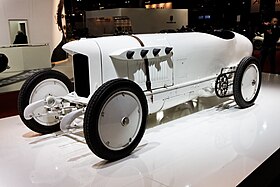Blitzen Benz
| Blitzen Benz | |
|---|---|
 |
|
| Overview | |
| Manufacturer | Benz & Cie |
| Production | 1909 |
| Assembly | Mannheim, Germany |
| Body and chassis | |
| Class | Racecar |
| Body style | Roadster |
| Layout | Front engine, rear-wheel drive Dual-chain drive |
| Powertrain | |
| Engine | 21,504 cm3 (1,312.3 in3) I4 |
| Transmission | 4-Speed Manual Gate-type shift |
| Dimensions | |
| Wheelbase | 2,800 mm (110.2 in) |
| Length | 4,820 mm (189.8 in) |
| Width | 1,600 mm (63.0 in) |
| Height | 1,280 mm (50.4 in) |
| Curb weight | 1,450 kg (3,196.7 lb) |
In 1909, the Blitzen Benz was a race car built by Benz & Cie in Mannheim, Germany, that broke the world land speed record in 1910. It was one of six cars built to improve its aerodynamics, with a 21,504 cm3 (1,312.3 in3), 200 hp (149.1 kW) inline four engine enlarged from the company's Grand Prix racer.
Of the six Blitzen-Benz ever made, two survive—Mercedes-Benz owns one, while the other belongs to a U.S. collector.
At Brooklands on 9 November 1909, land speed racer Victor Hémery of France set a record with an average speed of 202.7 kilometres per hour (126.0 mph) over a kilometer. On 23 April 1911, Bob Burman recorded an average of 228.1 kilometres per hour (141.7 mph) over a full mile at Daytona Beach, breaking Glenn Curtiss's unofficial absolute speed record, land, sea or air, set in 1907 on his V-8 motorcycle. Burman's record stood until 1919.
After 1914 the car was rebuilt for circuit racing, undergoing a number of revisions before it was broken up in 1923. Several other examples of the 200 hp have survived.
...
Wikipedia
